By Wilson Fitt
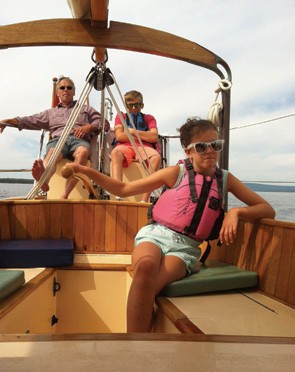
Olivia at the helm
Many years ago, when our three children were small, we spent an idyllic week on Cape Breton’s Bras d’Or Lakes on our Herreshoff 28 ketch, putting the bow up on the shore at Marble Mountain and pitching the tent on the beach. The kids swam, learned to row the dinghy, and messed around in boats to their hearts’ content.
They say you can’t go back, but this summer we did just that, this time with two of our grandchildren — Olivia, aged 10, and her first cousin Parker, aged 12 — aboard our 38-foot traditional cutter Christina Grant. It was one of the best weeks we have had in years, sailing, swimming, fishing, rowing and still messing about in boats.
The cruise started, sans grandchildren, from Chester, Nova Scotia, up to Halifax for a couple of days of showing family and guests around the harbor during the Tall Ships Festival. They were thrilled with the experience, some of them never having been on a sailboat before.
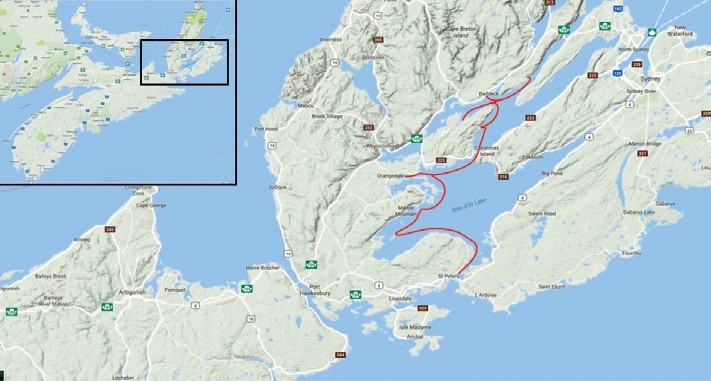
This cruise explored some of the loveliest places on Earth.
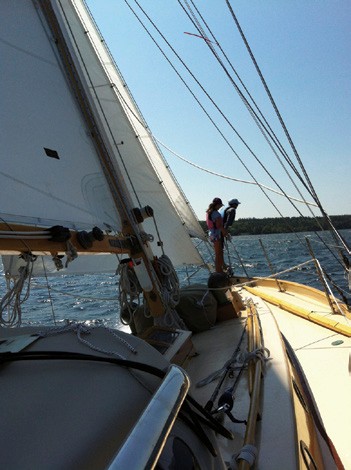
Leaving the hustle of the city behind, we spent a few days along the remote Eastern Shore of Nova Scotia, with stops in familiar and new anchorages, finally arriving at the St. Peters Canal, gateway to the Bras d’Or Lakes, escape hatch from the cold gray waters of the North Atlantic and home to general manager Gerry’s dependably friendly welcome at the St. Peter’s Marina. One more day’s sailing and we were in Baddeck, start of our main event for the summer.
Parker and Olivia on the bowsprit
The kids were driven down to Baddeck by their fathers. They seemed happy to escape back-seat imprisonment and walk uptown for ice cream and snacks, then go aboard to stow their stuff in the two lockers that we had cleared out for them. The indisputable wiring difference between boys’ and girls’ brains was evident. Olivia carefully unpacked her stuff and laid it out on her berth to show to her grandmother before stowing it tidily. Parker jammed his knapsack into the locker without even bothering to open it, and spent the rest of the week digging about blindly for anything that seemed clean or dry.
Next morning was spent shopping for provisions (kids that age eat more than grownups!), snazzy sunglasses for Olivia and fishing lures for Parker. Right after lunch, we got under way in bright sunshine and a brisk southwesterly for a downwind run along Great Bras d’Or Channel to Surprise Cove.
The lovely things about cruising in the Bras d’Or Lakes are that the brackish waters are warm and protected, the scenery is beautiful, the next anchorage is rarely more than a few miles away, and there is a reasonable probability that you will have it to yourself. Surprise Cove, about seven miles from Baddeck, is an old gypsum quarry reached via a shallow, narrow passage that extends from the head of Big Harbour (not actually very big at all) to a deep, enclosed basin surrounded by gypsum cliffs. Cruising Club of America (CCA) member Waring Partridge owns much of the shoreline thereabouts and hosted one of the memorable events of the CCA 90th Anniversary Cruise in 2012. Regrettably, he wasn’t in residence when we were there this summer.
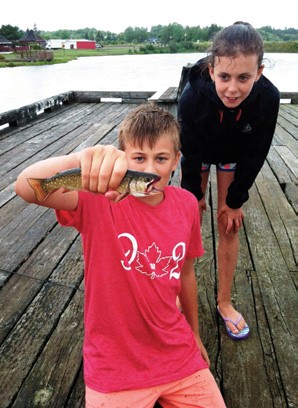 Parker caught this colorful trout at Orangedale.
Parker caught this colorful trout at Orangedale.
This anchorage set the tone for the rest of the week: everyone in for a swim, followed by the old folks settling down with their books and the young folks exploring the shore in the dinghy, fishing (with sparse results), more swimming, and waiting patiently for late afternoon snacks to materialize.
We have an old copy of Cruise Cape Breton with sketch charts of the various anchorages that have been republished in many subsequent guides. On the Surprise Cove page, there is a note in my handwriting that says “biggest mosquitoes in Cape Breton.” We had no problem during the day, but the note came true as darkness fell and our defenses were shown in need of some upgrading. Who’d have thought that mosquitoes could find their way through a dorade box?
The morning dawned bright, still, and mosquitoey. We moved out to reanchor close to the beach, across from Waring’s property where there was a bit of breeze, and enjoyed breakfast and morning dips. The wind came up briskly from the southwest, and we had a lively beat back up the Great Bras d’Or Channel. The kids hoisted the sails with some help, ground the double headsail sheet winches at each tack, becoming more efficient each time, and rode the end of the bowsprit between tacks.
This day’s voyage was all of 12 miles, up past Baddeck to the Washabuck River (dubbed “Wash-yer-butt” in pre-adolescent fun speak). This is another spot with a long CCA history. The late Charles Vilas and the very present Henry Fuller are, with many others, responsible for the preservation of much of the Washabuck shoreline in its natural state. We picked Indian Cove from among the several excellent anchorages, and enjoyed a repeat of the previous day’s strenuous afternoon agenda.
On the third day, calm and clear, we decided to go to Iona for a shore excursion to visit the Highland Village, a living museum that explains and celebrates the Scottish history and traditions in Cape Breton. My family roots are here, so this is of particular interest to me. Iona is a small village where the Barra Strait, crossed by highway and railway bridges, connects two major portions of the Bras d’Or Lakes. We anchored off the popular swimming beach on the north side of the bridges and soon realized that the walk up the hill to the museum was longer than we remembered from a previous visit. But, as luck would have it, a phone company guy said that he would give us a lift if we could all crowd into the cab of his truck, which we accomplished in a jumble of arms and legs.
We had an excellent lunch at the pub next to the museum entrance with an absolutely fabulous view over the lake, followed by a delightful couple of hours in the exhibit houses. They are organized chronologically, starting with a stone hut from the Scottish Highlands, moving through the first log houses that settlers would have built on arrival, then to more elaborately finished houses, barns, and workshops. The kids announced that this was one of the highlights of the whole cruise.
We walked the couple of kilometers back, mostly along the old rail line to avoid the hills and road traffic. As in many parts of Cape Breton, old farms have left behind the remnants of apple orchards. We stopped to pick small hard apples from one of the trees along the rails, and later made surprisingly good applesauce for breakfast.
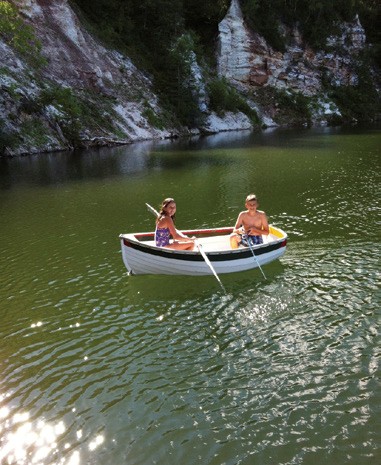 Olivia rows in Surprise Cove while Parker tries his luck with a fishing rod.
Olivia rows in Surprise Cove while Parker tries his luck with a fishing rod.
The day was wearing on, so we upped anchor, another children’s task now that we have a nice electric windlass and wash-down pump, and backtracked a couple of miles to the always lovely Maskells Harbour, birthplace of the CCA. There was time enough for the kids’ obligatory swim and messing about on the beach while I walked up the hill to Boulaceet Farm, owned by Harry Anderson, Larry Glenn and Dev Barker. Harry had been there a few weeks before and Larry was expected a few days hence, but Dev was home, so he and I had a chance to share a drink and a chat.
The only downside to Maskells Harbour is that an outfit in Baddeck that rents jet skis by the hour apparently tells everyone that Maskells is the place to go. Jet skis are the mosquitoes of the boating world: highly annoying, buzzy things that make you want to give them a swat. But unlike mosquitoes, they go away as the sun dips, leaving everything in peace.
The fourth day, with rain threatening, we motored back down to Barra and under the bascule bridge, waving to the bridgemaster, much to the delight of the kids. A lovely sail took us through a series of narrow but deep and winding channels between islands, into Denys Basin and thence to the old wharf at Orangedale. Parker’s diligent fishing finally resulted in several small mackerel and a trout, too small to keep but still very satisfying. The rain had started in earnest by late afternoon, so we had a quiet evening playing team Scrabble, the boys finishing way ahead of the girls.
After another very still night (by now we had the mosquito defenses effectively deployed), we got underway early in the damp morning for Pellier Harbour, kids still curled up in their berths. This was an 11-mile trip, short enough for a late breakfast on arrival. Here we were able to put the bow of the boat on the steep beach, as we used to do so long ago at Marble Mountain. Pellier Harbour is a lovely spot, with only two houses visible on the far shore and no sign of life. It seems to be far enough away from Cape Breton cottage country to keep the jet skis and motorboats away. We had the anchorage all to ourselves to swim, fish (but not catch), mess about on the beach and be very lazy in the warm sun.
The sixth day dawned with a good stiff westerly breeze. We tucked a reef in the main and beat up West Bay, headed for the Crammond Islands, Parker and Olivia working the winches enthusiastically at each tack and dipping their hands and legs in the water on the leeward side as we heeled over. The distance covered was eight miles in a straight line, just about far enough for a windward thrash in my opinion. It must seem repetitive by now, but the Crammond Islands provide another uninhabited, very protected, sandy beach harbor. There is a bit more traffic but nothing objectionable.
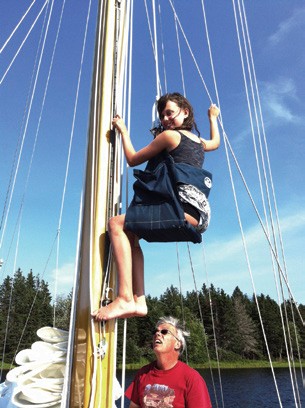
Olivia prepares to ascend Christina Grant’s mast.
In the afternoon, I asked the kids if they wanted to go up the mast in the bosun’s chair. They got to the lower spreaders on the first try, then screwed up their nerve to go to the upper spreaders. By the time the cruise was over, Parker was at the masthead. Olivia went all the way a few weeks later, along with one of her 10-year-old friends. This is no small feat for children of this age. I am pretty white knuckled up there and most people wouldn’t go up on a bet.
That brought us to the final day of the cruise, back to St. Peter’s on yet another bright day with no wind to speak of. Of all the unlikely things, the kids had become fascinated with the CCA yearbook by this time and spent endless hours looking at the pictures, debating which boat they liked best and drawing ever more elaborate designs with features like hot tubs, trampolines, and elevators.
When we rounded the final corner to St. Peter’s Marina, they shouted with excitement over a boat flying the CCA burgee and immediately went to the book to see who it was. It turned out to be the lovely Maverick, a 2015 Hanse 505 owned by Nancy Jamison and Steve McInnis. The kids were thrilled to have a tour and deeply impressed by the space (“They even have bedrooms!”) and all the fancy features. Our traditional wooden boat may never look the same to them again.
One more night aboard and then Olivia’s father, our eldest son Jason, arrived to deliver both kids back to the real world, leaving us to venture back into the gray Atlantic to get the boat home again. What a wonderful week we had together!
Wilson Fitt has been cruising the coast of Nova Scotia since he was a teenager. He and his wife, Thelma Costello, built their 38-foot Bill Atkin cutter Christina Grant in their backyard, launched it in 1999, and with various combinations of family and friends as crew, sailed it to the Caribbean, Bermuda, and Newfoundland. In 2009 Wilson singlehanded Christina Grant transatlantic to Scotland, where he and Thelma spent two years exploring Scotland and Ireland. He returned from Ireland to Nova Scotia in 2012, doublehanded with one of his sons. Back home in Nova Scotia, Wilson oversaw the restoration of the Bluenose II, replica of the legendary Grand Banks fishing schooner, racing champion and Canadian icon Bluenose.
Editor’s note: This article was originally published in the 2018 edition of Voyages, the Cruising Club of America’s (CCA) annual publication, and is reprinted with permission. Special thanks to CCA Commodore W. Bradford Willauer and Voyages Editors Jack and Zdenka Griswold.
The Cruising Club of America is comprised of more than 1,300 accomplished ocean sailors who willingly share their cruising expertise through books, articles, blogs, and onboard opportunities. Together with the Royal Bermuda Yacht Club, the CCA organizes the legendary Newport Bermuda Race. With active involvement and support from its 14 stations and posts around the United States, Canada and Bermuda, the club focuses significant national and international outreach efforts on ocean safety and seamanship training through hands-on seminars. The CCA’s Bonnell Cove Foundation makes grants to non-profit organizations for projects in safety at sea and environmental protection. For more information, visit cruisingclub.org




